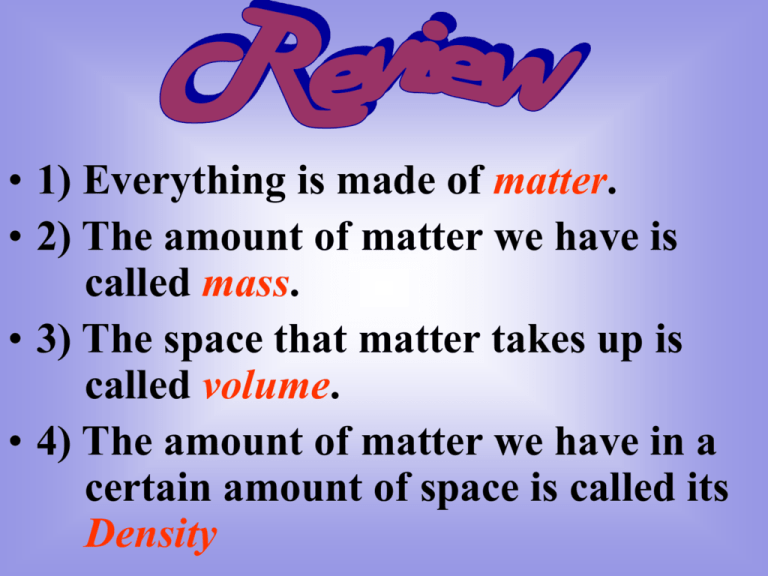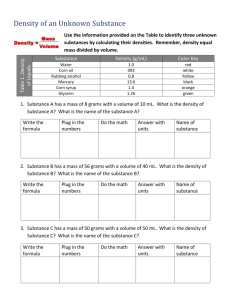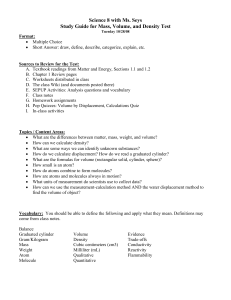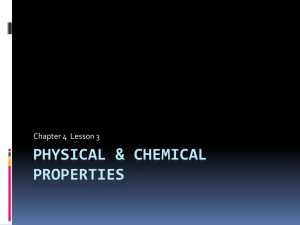Density - Junction Hill C
advertisement

• 1) Everything is made of matter. • 2) The amount of matter we have is called mass. • 3) The space that matter takes up is called volume. • 4) The amount of matter we have in a certain amount of space is called its Density For example: You have found a cube of iron. To find its mass you will have to compare it to something else whose mass we already know. How do you think we could measure its mass? That’s right, use a balance Basically there are two ways to measure the volume of an object. It depends on its size and shape as to which method you will use. Also, the unit for volume is always cubed. (cubic centimeters or cm3 ) • To find the volume of a regular shape like a cube or a shoe box, all we have to do is measure its – Length – width and – height – then do some easy multiplication If the Length= 6 cm, the Width = 4 cm and the Height = 2 cm. The formula for volume is: Length x Width x Height = Volume What is the volume of the box? 6 cm. x 4 cm. x 2 cm.= ? • If you got 48 you left something out. • It is very important give the unit of measurement so everyone knows what you are talking about. • The correct answer is 48 cm3. • Don't forget the unit is always cubed. • There is another way to find the volume of something and that is by using the water displacement method. This method is particularly good to use when you have object that doesn't have a regular box like shape. • For this method you will need water and a graduated cylinder. • 1)Let's say you have a little object. • 2) Fill a graduated cylinder with enough water to cover the object. • 3) Carefully lower the object into the graduated cylinder so no water splashes up on the sides. • As the object goes into the water, the water will be displaced and go up. • 4)The distance the water goes up is the volume of the object. What do you do if the object you have is too large to fit into a graduated cylinder? 1) Let's say you have found a rock. 2) Instead of putting the rock into a graduated cylinder, you will use a beaker filled to the top with water. 3) You have to be very careful and put the rock in slowly. 4) Since the water will overflow make sure you place a dish under the beaker to catch the water. 5) After you have put the rock into the water and it stops overflowing, carefully pour the water from the dish into a graduated cylinder to measure the water. 6) Check the level of the water and you will have the rocks volume. • You have three containers of equal size, one filled with cement, one filled with water, and one filled with air. 1. Which container would have matter that is very tightly packed? 2. Which container would have matter that is loosely packed? 3. What would happen if you put the cement, water and air into one large container? Take a look at the two boxes below. Each box has the same volume. If each ball has the same mass, which box would weigh more? Why? • The box that has more balls has more mass per unit of volume. • This property of matter is called density. • The density of a material helps to distinguish it from other materials. • Since mass is usually expressed in grams and volume in cubic centimeters, density is expressed in grams/cubic centimeter. We can calculate density using the formula: Density= Mass/Volume. • calculate the density of two blocks. • Block I • Mass = 79.4 grams • Volume=29.8 cubic cm. • Block II: • Mass= 25.4 grams • Volume=29.8 cubic cm. • What is Block I? • What is Block II?










